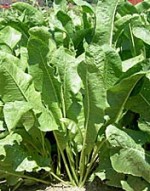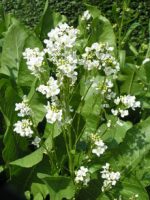 This herbaceous perennial is a member of the mustard family, Brassicaceae, that also includes broccoli, alyssum, and stock. It’s origin is obscure but it is believed to be native to eastern Europe and western Asia. The plant grows 2-3′ tall, has a long, white, tapering root, and forms a rosette of coarse, dark green leaves that are up to 3′ long, shiny, and toothed. Small, white, fragrant flowers are carried in dense terminal racemes in mid-summer. The plants are too coarse to be grown ornamentally but the root can be harvested and made into a condiment or spice that is delicious with meat and in cocktail sauce for shrimp. Because the plants are vigorous and fairly large they can crowd out most weeds and spread invasively especially if the roots are not harvested every year. The common name, horseradish comes from the words horse in the sense of coarse, and radish, which its root resembles. The genus name, Amoracia, is the classical Latin name for a related plant. The specific epithet, rusticana, is the Latin word meaning pertaining to the country.
This herbaceous perennial is a member of the mustard family, Brassicaceae, that also includes broccoli, alyssum, and stock. It’s origin is obscure but it is believed to be native to eastern Europe and western Asia. The plant grows 2-3′ tall, has a long, white, tapering root, and forms a rosette of coarse, dark green leaves that are up to 3′ long, shiny, and toothed. Small, white, fragrant flowers are carried in dense terminal racemes in mid-summer. The plants are too coarse to be grown ornamentally but the root can be harvested and made into a condiment or spice that is delicious with meat and in cocktail sauce for shrimp. Because the plants are vigorous and fairly large they can crowd out most weeds and spread invasively especially if the roots are not harvested every year. The common name, horseradish comes from the words horse in the sense of coarse, and radish, which its root resembles. The genus name, Amoracia, is the classical Latin name for a related plant. The specific epithet, rusticana, is the Latin word meaning pertaining to the country.

Type: Perennial herb.
Bloom: Small white flowers are borne in terminal racemes in mid-summer.
Foliage: Lower leaves coarse, up to 1 long, and oblong; upper leaves smaller and lanceolate.
Size: 2-3’ H x 2-3’ W.
Light: Full sun but tolerates partial shade.
Soil: Rich, loose, deeply cultivated, moist, well-drained.
Hardiness: Zones 5-9; prefer cool summers.
Care: Best planted in a container sunk in the ground because plants rapidly multiply. Every piece of root left in the soil after harvesting potentially can give rise to another plant.
Pests and Diseases: None of significance
Propagation: Root divisions in early spring: set crowns at soil level. Root cuttings in early spring: take eight-nine inch cuttings from young roots that are about ½” in diameter. Cut the top part at an angle and place in a four-five inch deep trench 24-36” apart. Sprinkle with two-three inches of loose soil.
Companion plants: Said to make potatoes more disease resistant.
Harvesting: For the best flavor, harvest young roots after the first frost and throughout the winter as weather permits. Harvested roots can be kept in a cold cellar or the crisper of the refrigerator for months. The odor and taste of horseradish is due to a volatile oil that is only released when the cells are broken or damaged so will not decline significantly in storage.
For directions on preparing horseradish for the table see my post “How to Prepare Horseradish”.
